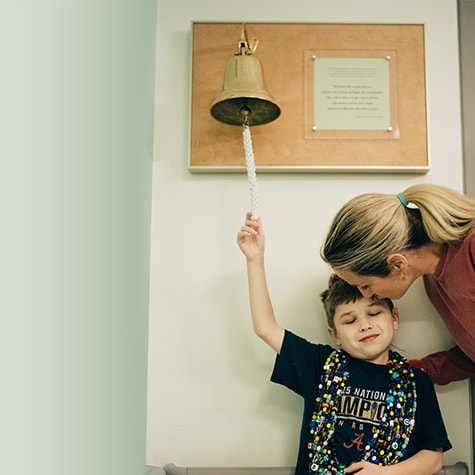During a blood and marrow transplant (BMT), also commonly known as a bone marrow transplant, your child will receive healthy stem cells to help restore bone marrow stem cells that are damaged, missing or not working. A BMT is not a surgery. It is a treatment that can take place over a number of weeks and months, when transplant cells are given intravenously (through a vein) like a blood transfusion.
At the Aflac Cancer and Blood Disorders Center of Children’s Healthcare of Atlanta, we understand that a BMT can seem alarming and overwhelming. But our highly skilled team of experts is here to walk your family through every step of the process, providing the information and resources needed to help everyone feel confident, supported and informed about the procedure.
As one of the largest BMT programs in the country, we perform more than 70 lifesaving BMTs each year. Our volumes and survival rates are a testament to the level of expertise and quality of care each patient and family receives at the Aflac Cancer and Blood Disorders Center.
Stories of Hope and Inspiration From Patients Who Received a BMT at the Aflac Cancer and Blood Disorders Center
The first few steps of preparing your child for a BMT may involve him undergoing chemotherapy and/or radiation treatments. This is called a conditioning regimen. The kind of therapy your child needs will depend on his disease and health. Your child will start therapy about five to 22 days before a BMT, depending on the conditioning regimen prescribed.
Chemotherapy
Your child will have chemotherapy, even if he does not have cancer, because it:
- Stops your child’s bone marrow cells from fighting the new blood and bone marrow.
- Clears the bone marrow of your child’s cells, making room for the new donor marrow cells.
- Kills any cancer cells if your child has cancer.
Side effects of chemotherapy may include:
- Nausea or vomiting
- Loss of hair
- Mouth sores
- Poor appetite and diarrhea
Radiation
Your child may need radiation before his BMT to help kill any cancer cells and help his body accept the graft. This therapy uses strong X-rays aimed at your child’s cancer once or twice a day for 10 to 15 minutes.
Side effects of radiation may include:
- Red skin like a sunburn
- Sensitive skin to perfumes, soaps and deodorants
- Nausea and diarrhea
- Dry mouth
The early stages of the BMT process include collecting healthy blood or bone marrow for a transplant to help restore bone marrow stems cells. This is called a graft and can be done in three ways:
- Bone marrow harvest: For a bone marrow collection, blood stem cells are most often collected from bone marrow in the hip bone. The hip bone has a large amount of bone marrow and is easy to access. This is done in the operating room while the donor is under general anesthesia. The total number of cells removed depends on the weight of your child and the weight of the donor. The bone marrow collection takes about one hour.
- Peripheral blood stem cell collection: Blood moving through the bloodstream is called peripheral blood. Blood stem cells can be removed from the peripheral blood. The donor may receive a medicine called a growth factor—granulocyte-colony stimulating factor (GCSF) or granulocyte macrophage-colony stimulating factor (GM-CSF). This medicine helps the bone marrow make a lot of new blood stem cells quickly and pushes them into the bloodstream. The blood stem cells are collected through a large IV in the arm or a central venous line (CVL) into a machine called an apheresis machine. The machine returns other important cells, including red blood cells, white blood cells, platelets and plasma, back into the donor’s blood. The machine does not cause pain.
- Umbilical cord blood collection: The placenta and umbilical cord of a newborn baby are a rich source of blood stem cells. The blood stem cells can be collected soon after a baby is born by cutting the umbilical cord or removing the blood from the cord and placenta right away.
Day 0
The day of your child’s BMT is called Day 0, which is when your child will get the new blood stem cells infused through an IV.
What the recovery process will be like for your child after a BMT
Recovery starts in our hospital, but since each child is different, it may last several months after your child is discharged. Our doctors and nurses will let you know how your child is doing and when he can go home. On average, children who have:
- Autologous transplants will stay in the hospital for two to three weeks.
- Allogenic transplants will stay in the hospital three weeks to a little over a month.
Health issues your child may experience after a BMT
Our staff will monitor your child each day he is in the hospital, checking him for:
- Infections
- Low red blood cells (anemia)
- Low platelets (thrombocytopenia)
- Low white blood cells
- Fever
- Mouth sores (mucositis)
- Diarrhea
- Irritation of the urinary bladder causing bleeding (hemorrhagic cystitis)
- Stress to other organs, such as the kidneys, liver, heart or lungs
- Graft-versus-host disease (GVHD)
Engraftment is when healthy donor cells begin to grow. It usually happens about two to four weeks after a BMT.
Your child will need to take some steps in his everyday life to stay healthy and active, including paying close attention to:
- Infections: Your child’s immune system is very weak the first six to nine months after a BMT, which makes it difficult to fight off common infections like a cold. This is because the immune system is new, and your child will need to take medication in the early months after a transplant. However, these medicines help prevent rejection of the new bone marrow and GVHD. To prevent infections, your child cannot go anywhere during his recovery where there are a lot of people, including school, church, stores and other people’s homes. Any signs of infections should be brought to the attention of your BMT medical team immediately.
- GVHD: GVHD is when the graft that is made up of donor cells can sense your child’s body (the host) as different. Donor cells will then attack your child’s body. It only occurs in allogeneic transplants, because the donor cells are from someone else. Having your child take his medication on time every day is the single most important thing you can do to help prevent GVHD.
- Medication: Your child may have to take medicines for months after his BMT. It is important that he takes all of his medicine on time every day. Taking his medication on time is the best way to prevent GVHD and stay healthy throughout the recovery process.
- Mouth care: Your child’s system for fighting infections in his mouth is also weakened by the procedure. It is important to regularly clean his mouth to help keep him from getting mouth sores that could become infected.
- Blood pressure: Your child’s blood pressure may be high as a result of his medication. This is called hypertension. Though this is normal for children who undergo a BMT, your child may also need to take medicine to control his blood pressure.
- Body changes: Your child may see some changes in his body, including weight gain or weight loss, skin color changes, acne or stretch marks, and more facial or body hair. For teenagers already undergoing body changes, their skin may be darker, more sensitive or dry for many months. Most of these changes will go away with time or as his medications change.
- Sun protection: The sun is even more dangerous if your child has had a BMT. It can cause skin cancer and trigger GVHD, or make it worse. To protect your child, he should wear protective clothing and use sunblock with 30 SPF or higher.
- Pets: Most pets are fine, but talk with your doctor to see if it is OK to have a pet near your child.
- Nutrition: Making sure your child eats well is important after a BMT. Our team will provide food safety instructions to follow.
- Vaccines: Your child’s immune system for fighting diseases will be weakened. We recommend checking with us if your child needs any vaccines the first year after his transplant. Any vaccines given before the transplant for those receiving an allogeneic transplant will no longer work. They will need their vaccines administered again, and these will be given starting six months after the transplant, spread out over a period of months. We can give your family doctor a vaccine schedule to follow to help make sure your child does not get a vaccine too soon.
- Going back to school: It is important your child not return to school until it is medically safe. This can take six to nine months. Every child recovers differently. We will work with you to get your child back to school as soon as possible, but while he is out of school, our social worker will assist your child’s school in enrolling him in a homebound school program.
Having a child undergo a BMT can be an emotional and overwhelming experience. At the Aflac Cancer and Blood Disorders Center, our No. 1 priority is to support your family. Whether discussing treatment options or prepping your child for a bone marrow transplant, we make it our mission to provide the best care—and best experience—for every child. Family is a big part of your child’s well-being. Not only are you a vital member of his or her healthcare team, you are a source of security and comfort.

We work to support your whole family while your child is in our care—and after she goes home.

The Aflac Cancer and Blood Disorders Center is pushing for newer and better treatments for our kids.
When kids do face cancer and blood disorders, the Aflac Cancer and Blood Disorders Center is here to help with outstanding clinical care and nationally recognized research.
DONATE TODAYContact Us 404-785-1112





